I have a current source that produces a 1 kHz 1 mA sinusoidal current. Unfortunately it also outputs a small DC offset current (microamps). The current source does have a small trim pot to zero out the offset, but it is never perfect, and I need to hook this current source up to another circuit that can't sink any net current. Therefor I'd like to "filter out" the small offset current. My first attempt was to put a fairly large capacitor (1 microF) in series to block the offset. This would work if it were a voltage source, but since it is a current source, the small trickle of current eventually charges up the capacitor until it hits its voltage rails since there is no way for the current to escape. Can you suggest a way to zero out the current source reliably other than just twiddling the trim pot? Thanks!
-
My first thought is that the current equivalent of a capacitor-in-series would be an inductor-in-parallel. – user253751 Jun 07 '18 at 23:49
-
That's quite helpful. I ran a quick simulation and that works of course, but the inductor must be quite large, depending on the resistance of the load, to preserve the frequencies I care about around 1 kHz. And big inductors have considerable series resistance that then leaves some offset in the output. – NeuralEngineer Jun 08 '18 at 01:25
-
Is the rogue DC current always positive? Does it drift around? Can it become negative? – Andy aka Jun 08 '18 at 09:05
-
The rogue DC current drifts around +/- 5 microA. It can be negative. – NeuralEngineer Jun 08 '18 at 14:16
3 Answers
If you are not too concerned about the output impedance being too low you can add a resistor to ground before the capacitor. For example, if you have 2uA offset and add 470K the offset will settle out at ~1VDC. The resistor decreases the output impedance and the offset voltage reduces the compliance.
Edit: Like this:-

simulate this circuit – Schematic created using CircuitLab
You could also add a slow feedback loop to cancel out the average output voltage.
Or use more accurate parts in your current source to reduce the offset current (perhaps a zero-drift amplifier) and avoid the capacitor.
- 376,485
- 21
- 320
- 842
-
I suspect if target circuit "can't sink any net current" it probably cannot sink any current at all, i.e. it is voltage input. If that is the case then your suggestion is better explained as: sink the current through the resistor and use voltage across it as input for next circuit (via cap if necessary). However I also wonder what "trim pot to zero out the offset" means? If it is uni-polar output it never "zeroes", it is trimmed to center-point (1V in your example). Could it be that the source has return wire as well? Then the resistor would not work. – Maple Jun 07 '18 at 22:59
-
It is a bipolar circuit (goes both positive and negative, centered on zero). The receiving circuit isn't actually a voltage input. Putting it across a resistor would be a good idea if it were. The receiving circuit is actually an electrochemical reaction that can be damaged by unbalanced current. The trim pot lets you set the offset to near zero, but it isn't near enough to zero for this application. – NeuralEngineer Jun 08 '18 at 01:40
-
The resistor is on the current source to ground, then couple that with a capacitor to the load. Hopefully that is clear enough, no ability to do a schematic at the moment. – Spehro Pefhany Jun 08 '18 at 01:58
-
1I implemented the 470 kOhm resistor to ground as Spehro suggested, and it totally worked. – NeuralEngineer Jun 08 '18 at 17:28
-
Consider using a 1:1 transformer rated for the appropriate impedance, current and frequency range. It won't pass DC.
Depending on the precision needed, it might not be an exactly 1.000:1.000 current ratio, so a calibration step should be included.
Audio transformers for 600 Ohm drive are usually pretty good around this frequency.
- 1,860
- 1
- 10
- 10
-
Great suggestion--I can see how that would work pretty well in many circumstances and it would be easy to implement. In my case, that would lower the output impedance too much for my particular application, but I didn't mention that initially. Thanks – NeuralEngineer Jun 11 '18 at 19:36
Turn off the current source by adding a mosfet in series with the current source.

simulate this circuit – Schematic created using CircuitLab
- 75,799
- 36
- 80
- 208
-
Sinking the current through a mosfet when it isn't in use would probably solve my problem. Thanks for the suggestion. I was hoping for a passive solution though. The added mosfet wouldn't work so well for continuous (e.g. sinusoidal) signals, but it would for intermittent pulses that are zero for a majority of the time. – NeuralEngineer Jun 08 '18 at 01:44